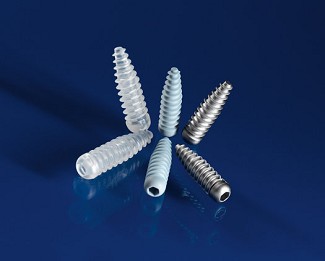New Biodegradable Screws Won’t Necessarily Replace Titanium in Surgery
FEATURE

The new composite screw (center) with titanium screw (right) and older polylactic acid screw (left) (courtesy the Fraunhofer Institute)
The Fraunhofer Institute for Manufacturing Engineering & Applied Materials Research announced a biodegradable screw to replace metal screws traditionally used in broken bone surgery.
An orthopedic surgeon interviewed by GlobalFastenerNews.com responded that biodegradable screws are not about to eliminate titanium and other metallic screws in bone surgery. They also may cost multiple times the price of stainless steel screws for surgery.
The Fraunhofer screws are made of polylactic acid, hydroxylapatite and medical stainless steel.
Patients previously had to undergo surgery to remove the titanium after the bone healed, the Bremen, Germany-based IFAM said. The new screws biodegrade within two years.
Previous biodegradable screws were made of polylactic acid. However, those leave holes in the bone after they degrade.
IFAM researchers developed the moldable composite made of polylactic acid and hydroxylapatite. It is a ceramic that Philipp Imgrund of the IFAM biomaterial technology department described as the main constituent of bone material.
“We have modified biomaterials in such a way that they can be formed into robust bioactive and resorbable screws by means of a special injection molding process,” Imgrund explained. “Depending on the composition they biodegrade in 24 months.”
Pluses & Minuses
Orthopedic surgeon Matthew Shapiro MD told GlobalFastenerNews.com that non-metallic implants are not eliminating titanium and metal screws for medical use.
“The original idea was that bioabsorbable implants would allow better revision surgery,” Shapiro explained. For example, if an ACL reconstruction is reinjured “you’d have to remove the old screws, which would then leave a void in the bone that you would have to fill when doing the next reconstruction.”
Shapiro noted that those holes are difficult to fill. “They are soft spots that prevent you from getting good new fixation – like a stripped screw or a staple in silly putty,” Shapiro explained.
“The idea with biodegradable screws was that they would reabsorb, leaving no ‘void’ behind. In fact, that doesn’t happen. The early generation absorbable implants did so by having the body attack the polymer like a foreign invader – which it is.”
Reabsorbable implants can have problems, Shapiro pointed out. They can create an inflammatory response, which in some cases “cause even more resorption than you can imagine. You can get big bone cysts, and in some cases, particles fall into the joint and cause severe joint destruction.”
Medical companies also are trying cadaver bone, calcium, shellfish and hydroxyapetite – which is a chemical constituent of actual bone.
Will the alternatives be better? “Maybe,” Shapiro responded.
They will be expensive – “sometimes two or three or even more times the cost of a stainless steel or cobalt-chrome implant,” Shapiro noted.
Titanium also is used, but has been associated with some resorption problems as well, he observed.
“In general, metallic implants are really well tolerated in humans, particularly inside bones,” Shapiro said.
Price Tag
How much do these advanced medical fasteners cost?
“Low end a few hundred dollars, and high end a couple thousand,” Shapiro estimated. ” Simpler implants – like screws for a bone plate might be $20 to $30 each.” ©2010 GlobalFastenerNews.com
Related Links:
• Fraunhofer Institute for Manufacturing Engineering & Applied Materials Research



There are no comments at the moment, do you want to add one?
Write a comment